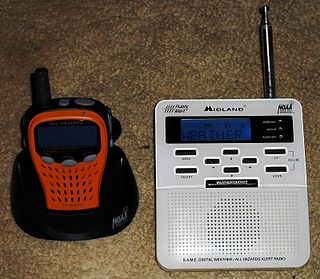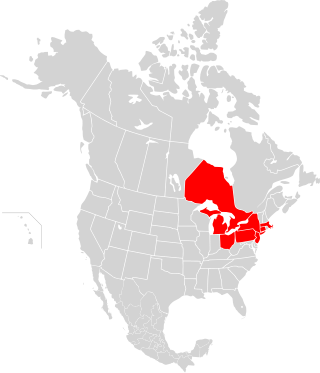Related Research Articles

NOAA Weather Radio (NWR), also known as NOAA Weather Radio All Hazards, is an automated 24-hour network of VHF FM weather radio stations in the United States that broadcast weather information directly from a nearby National Weather Service office. The routine programming cycle includes local or regional weather forecasts, synopsis, climate summaries or zone/lake/coastal waters forecasts. During severe conditions the cycle is shortened into: hazardous weather outlooks, short-term forecasts, special weather statements or tropical weather summaries. It occasionally broadcasts other non-weather related events such as national security statements, natural disaster information, environmental and public safety statements, civil emergencies, fires, evacuation orders, and other hazards sourced from the Federal Communications Commission's (FCC) Emergency Alert System. NOAA Weather Radio uses automated broadcast technology that allows for the recycling of segments featured in one broadcast cycle into another and more regular updating of segments to each of the transmitters. It also speeds up the warning transmitting process.

An emergency population warning is a method where by local, regional, or national authorities can contact members of the public to warn them of an impending emergency. These warnings may be necessary for a number of reasons, including:

The Peach Bottom Atomic Power Station is an American nuclear power plant that is located 50 miles (80 km) southeast of Harrisburg in Peach Bottom Township, York County, Pennsylvania. Situated close to the Susquehanna River, it is three miles north of the Maryland border.

CenterPoint Energy, Inc. is an American utility company based in Houston, Texas, that provides electric and natural gas utility to customers in several markets in the American states of Indiana, Ohio, Louisiana, Minnesota, Mississippi, and Texas. Part of the Fortune 500, the company was formerly known as Reliant Energy, NorAm Energy, Houston Industries, and HL&P. The company is headquartered in the CenterPoint Energy Tower at 1111 Louisiana Street in Downtown Houston.

A weather radio is a specialized radio receiver that is designed to receive a public broadcast service, typically from government-owned radio stations, dedicated to broadcasting weather forecasts and reports on a continual basis, with the routine weather reports being interrupted by emergency weather reports whenever needed. Weather radios are typically equipped with a standby alerting function—if the radio is muted or tuned to another band and a severe weather bulletin is transmitted, it can automatically sound an alarm and/or switch to a pre-tuned weather channel for emergency weather information. Weather radio services may also occasionally broadcast non-weather-related emergency information, such as in the event of a natural disaster, a child abduction alert, or a terrorist attack.

The Northeast blackout of 2003 was a widespread power outage throughout parts of the Northeastern and Midwestern United States, and most parts of the Canadian province of Ontario on Thursday, August 14, 2003, beginning just after 4:10 p.m. EDT.
A flood warning is closely linked to the task of flood forecasting. The distinction between the two is that the outcome of flood forecasting is a set of forecast time-profiles of channel flows or river levels at various locations, while "flood warning" is the task of making use of these forecasts to make decisions about whether warnings of floods should be issued to the general public or whether previous warnings should be rescinded or retracted.
The HEARO Local Alert Receiver was an emergency management tool to relay and display informational text messages in English, Spanish, French and German using RDS technology. It notified local residents in the event of an emergency within a matter of seconds. HEARO carried NOAA weather warnings and other public safety text alerts, using FM radio infrastructure with a 60-hour battery life, HEARO was able to work when electricity, telephone and Internet were unavailable. viaRadio Corporation of Melbourne, Florida manufactured and distributed HEARO receivers.
Floodline is the flood warning and information service used in the United Kingdom to issue flood alerts and warnings to the public, emergency organisations and businesses. The system uses observed data from rain, river and coastal gauges, combined with weather forecasts to accurately predict the likelihood and timing of flooding. When flooding is predicted within an area, a message is issued through the Floodline service. The service is accessed online or by the dedicated phone line, 0345 988 1188.

Wireless Emergency Alerts, is an alerting network in the United States designed to disseminate emergency alerts to mobile devices such as cell phones and pagers. Organizations are able to disseminate and coordinate emergency alerts and warning messages through WEA and other public systems by means of the Integrated Public Alert and Warning System.

The 2010 Tennessee floods were floods in Middle Tennessee, West Tennessee, south-central and western Kentucky and northern Mississippi areas of the United States of America as the result of torrential rains on May 1 and 2, 2010. Floods from these rains affected the area for several days afterwards, resulting in a number of deaths and widespread property damage.
ARCOS LLC is a software company based in Columbus, Ohio, USA, that provides an automated crew callout and resource management software system for finding, assembling and tracking repair crews for electric and gas utility companies. ARCOS LLC is often referred to simply as ARCOS. ARCOS is a supplier to American utility companies. The ARCOS System is a software-as-a-service subscription. The ARCOS System is also used by power generation plants to maintain plant efficiency.
An emergency communication system (ECS) is any system that is organized for the primary purpose of supporting one-way and two-way communication of emergency information between both individuals and groups of individuals. These systems are commonly designed to convey information over multiple types of devices, from signal lights to text messaging to live, streaming video, forming a unified communication system intended to optimize communications during emergencies. Contrary to emergency notification systems, which generally deliver emergency information in one direction, emergency communication systems are typically capable of both initiating and receiving information between multiple parties. These systems are often made up of both input devices, sensors, and output/communication devices. Therefore, the origination of information can occur from a variety of sources and locations, from which the system will disseminate that information to one or more target audiences.
Evacuation immediate is a warning issued through the Emergency Alert System (EAS) in the United States to notify the public of a mandatory evacuation due to a wildfire, approaching hurricane, or an imminent explosion due to a gas leak. It is typically issued by a local or state authority and is relayed by the National Weather Service. The warning can replace a Civil Emergency Message, Fire Warning, or other warnings when required.

National Weather Service - Norman, Oklahoma is a Weather Forecast Office (WFO) of the National Weather Service based in Norman, Oklahoma, which is responsible for forecasts and the dissemination of weather warnings and advisories for central and most of western Oklahoma, and western portions of north Texas. It is located in the National Weather Center on the University of Oklahoma campus, where it acts as one of the NOAA Weather Partners, a group of close-together weather-related agencies of the National Oceanic and Atmospheric Administration. NWS Norman is currently overseen by Mark Fox, who serves as the Meteorologist In Charge of the office.

The December 2013 North American storm complex was a significant storm complex that included many different types of severe weather, including a winter storm, a severe ice storm and a tornado outbreak that impacted the central and eastern portions of Canada, parts of the Central Great Plains, the Southern United States, and the northeastern United States from 20 to 23 December 2013. Formed in the South Central United States, the storm headed across the Great Plains towards Canada into Atlantic Canada and northeastern United States where the storm dissipated on 23 December 2013. The storm produced freezing rain and snow to the affected areas which caused massive damage to electric power transmission and trees. The storm resulted in 29 deaths, loss of power to over a million residents and over $200 million in damages. The storm produced similar conditions to the ice storm of 1998 which affected similar areas.

The February 13–17, 2021 North American winter storm was a crippling, large and major winter and ice storm that had widespread impacts across the United States, Northern Mexico, and parts of Canada from February 13 to 17, 2021. The storm, unofficially referred to as Winter Storm Uri by the Weather Channel, started out in the Pacific Northwest and quickly moved into the Southern United States, before moving on to the Midwestern and Northeastern United States a couple of days later.

The February 15–20, 2021 North American winter storm, also unofficially referred to as Winter Storm Viola, was a significant and widespread snow and ice storm across much of the United States, Northern Mexico, and Southern Canada. The system started out as a winter storm on the West Coast of the United States on February 15, later moving southeast into the Southern Plains and Deep South from February 16–17. It then moved into the Appalachian Mountains and Northeastern United States, before finally moving out to sea on February 20. The storm subsequently became a powerful low pressure system over the North Atlantic, before eventually dissipating on February 26.

In February 2021, the state of Texas suffered a major power crisis, which came about during three severe winter storms sweeping across the United States on February 10–11, 13–17, and 15–20. The storms triggered the worst energy infrastructure failure in Texas state history, leading to shortages of water, food, and heat. More than 4.5 million homes and businesses were left without power, some for several days. At least 246 people were killed directly or indirectly, with some estimates as high as 702 killed as a result of the crisis.
On December 20, 2022, a magnitude 6.4 earthquake struck Ferndale, California in Humboldt County, United States at 10:34:25 UTC, or 2:34 a.m. PST.
References
- ↑ "Local Area Emergency, Emergency Management of Nashville, TN". SevereWeatherLiker3. September 21, 2013.
![]() This article incorporates public domain material from Non-weather Related Emergency Message Description Guidelines (PDF). United States Government.
This article incorporates public domain material from Non-weather Related Emergency Message Description Guidelines (PDF). United States Government.